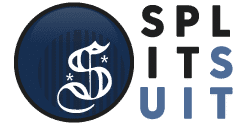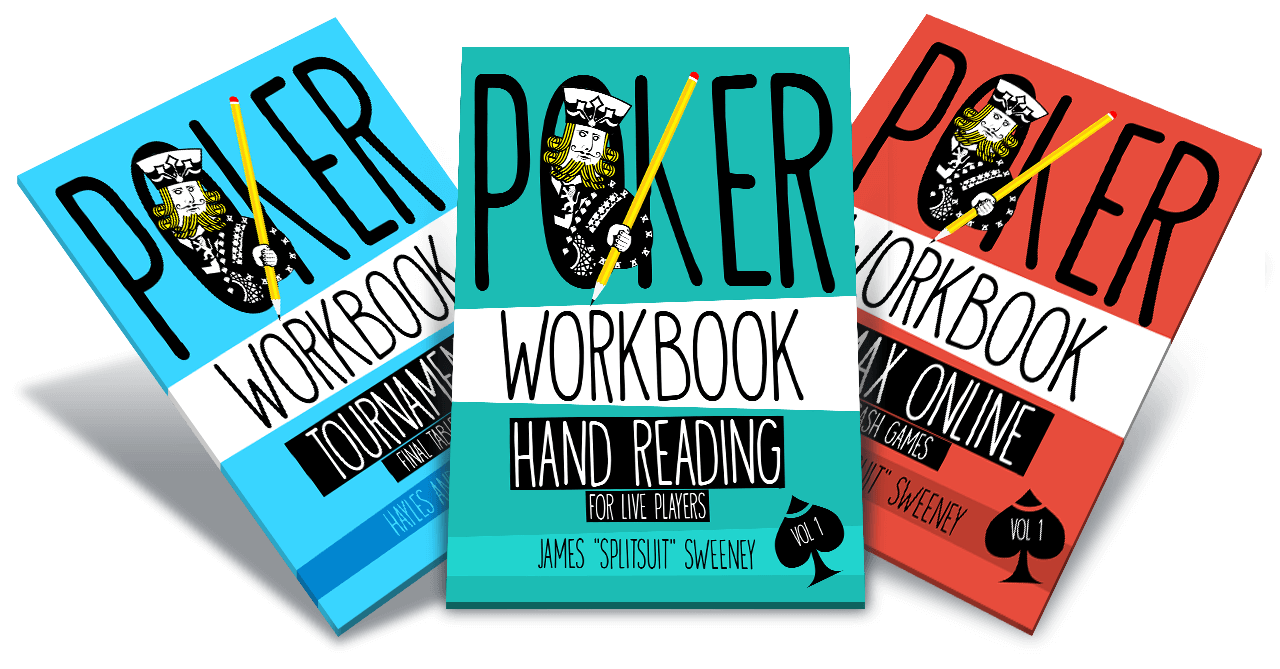Over the last year I have released three poker workbooks. These are first-of their kind workbooks that guide you through the hand reading/range building process and layout the kind of intense study that most players know they truly need.
That being said, I get an endless amount of emails that go something like this:
“I just bought your workbook. There is no answer key and I have zero idea if I am doing these exercises correctly.
What am I supposed to be getting from this?”
That seemed like the perfect kind of thing to write an article about. So here are a bunch of the major takeaways you should be getting from every exercise you complete…
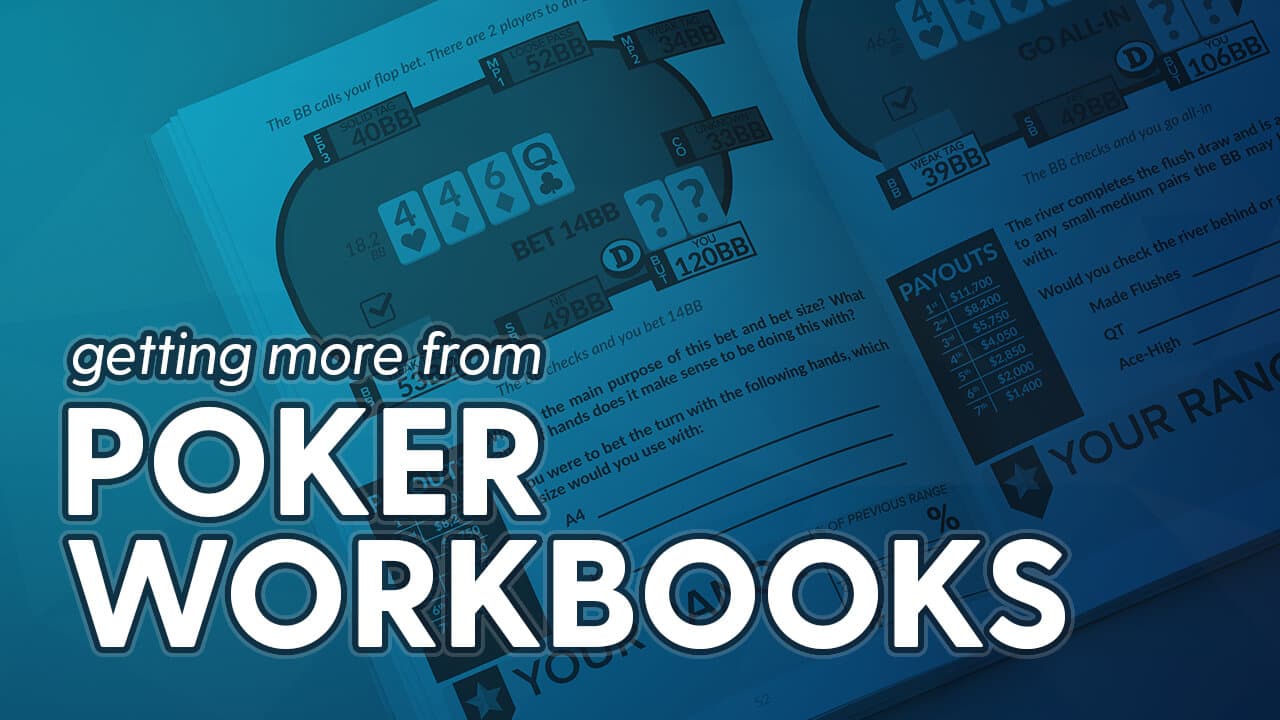
PREFLOP RANGE WIDTH
Everything starts at the beginning, and hand reading is no different. Whether you are doing an exercise from section 1 (hand reading yourself) or section 2 (hand reading your opponents), the action begins preflop and you have to build a preflop range.
This means 3 things:
1. Building a raw range of hands and thinking about what the weakest hand in that range would be. If you aren’t sure how to do this, read this guide to hand reading preflop.
2. Grabbing the %-form of that range
3. Grabbing the combo-form of that range
The preflop range width is simply #2 from the above list. If a player open-raises 22+/AJ+/ATs/KJ+/QJ/65s+, that is 15.2% of hands.
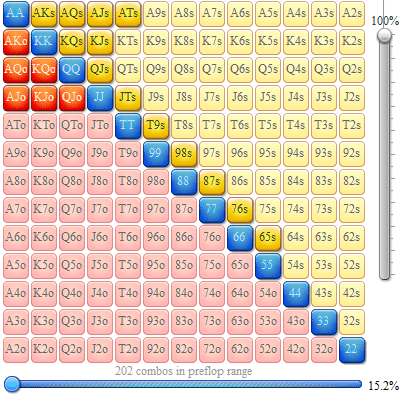
Understanding how wide a player’s range is preflop is particularly helpful since it sets the stage for what kind of hand strengths are possible postflop. For instance, you do not need to worry that the player who just open-raised 15.2% of hands is flopping two pair when the flop comes A73.
Since hand reading begins preflop, it’s of crucial importance that you get stronger at setting a correct range preflop and really understanding what hands are vs are not included when a player takes a specific action or has a specific frequency. Remember, a nit is not opening wide enough to include 75s in their open-raising range from EP, and a LAG is not playing tight enough to assume they aren’t at least calling with KJs against your MP open.
OVERALL COMBOS
A large takeaway from this book is to improve your technical skillset. This means understanding ranges from a frequency AND combo perspective. There are a couple reasons for this:
First, it’s vital that you understand how many combos of nuttish hands exist. If I tell you a player opened preflop with 22+/AJ+/KQ and they bet/3bet the flop on K82, do you know how many strong combos are available?
♦ There are 9 possible sets
♦ There are 12 possible AK combos
♦ There are 6 combos of AA
♦ There are 12 combos of KQ
For a whopping 39 combos of top pair+. And if they wouldn’t 3bet single pairs, that number of nuttish combos dries up rapidly…
But what if you had KTs in that same spot?
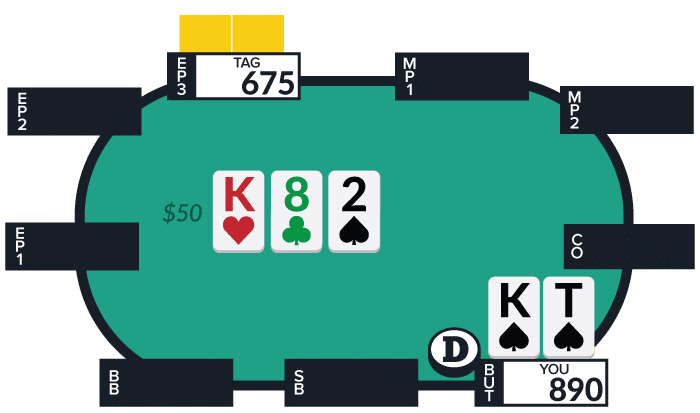
Now they can only have 29 combos of top pair+. This is something you start to intuit once you’ve worked through enough of these examples…
Secondly, it’s important to understand that you cannot add more nuttish combos. Take that same example from earlier, if you thought your opponent would actually bet/3bet about 70 combos of hands – there are no extra nuttish combos to add. You already maxed out the top pair+ combos, and now any extra combo you add into that range inherently has to get weaker and weaker.
Now, it could be QQ (weaker than top pair+), or it could be AJs with a backdoor flush draw, or it could be 55. There is nuance in which combos you actually add into the range. But just starting with “villain likely takes this line with 70 combos and only 39 are top pair+, means that 44% of their range is weaker than top pair.” This alone can help you see why over-folding can be to your detriment.
STRONG VS WEAK RANGE DENSITIES
While this isn’t a default question for each exercise in the workbooks, it’s something you should be pondering and exploring every step of the way. Of the range your opponent would actually play here, what density of it is strong vs weak?
Continuing with the example from earlier, let’s assume villain would bet/3bet the flop of K82 with top pair+ (I’m not saying this is a good play, rather just creating an example that we can go through together). That turns out to be 29 combos if we are holding KTs and we need to decide if we should hold or fold our top pair.
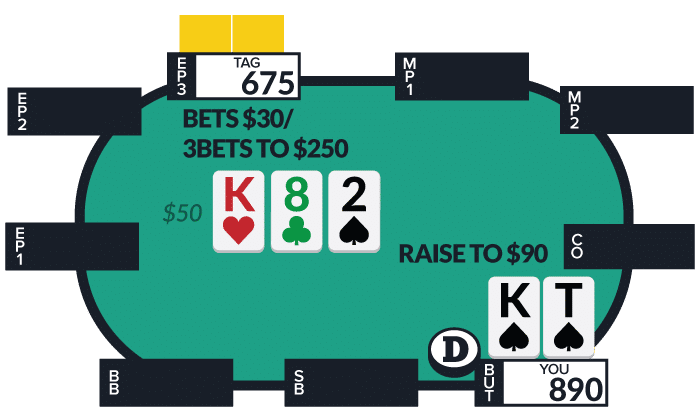
Well if villain would bet/3bet 70 combos, and only 29 combos are top pair+, it’s easy to see that 41 combos are worse than our KT. In fact, that means we are crushing their range 59% of the time and that folding would be awful.
But what if you thought villain would bet/3bet only 35 combos. Well then their range, while it contains some bluffs, has such a solid density of strong hands that crush our KT that folding becomes a more attractive option. (Of course, you should still estimate the implied odds of improving to two pair or a backdoor flush and getting paid off from a large combo count of AA/AK/KQ).
These densities are everywhere. Some of the major ones are:
♣ The density of hands in a player’s open-raising range that can withstand a 3bet (and also 4bet you)
♣ The density of hands in a player’s call2bet range that can withstand a squeeze
♣ The density of hands a player can give a flop CB action with
♣ The density of nuttish hands a player can show up with on the turn or river
By this point, you are starting to see how all of these takeaways bleed together. From understanding preflop ranges and basic combo breakdowns, you can begin to see strong vs weak range densities which in turn allows you to find extra bluffs and even hero folds with ease.
STREET-BY-STREET FREQUENCIES
Every exercise in the workbook starts by asking for the %-form of the original preflop range, and everything after that asks for “% of previous range”. This is pure gold if you know how to both estimate it and turn it into a useful line.
First, what is this telling you?
The “% of previous range” lets you know how often your opponent is continuing in this hand with the particular action. So if you CB and think your opponent would:
♠ Raise with two pair+ (10 combos)
♠ Call with any pair and gutshots, OESDs, FDs (161 combos)
♠ Fold with everything else (45 combos)
That means you expect they would raise 5% of the time, call 75% of the time, and fold the other 20%.
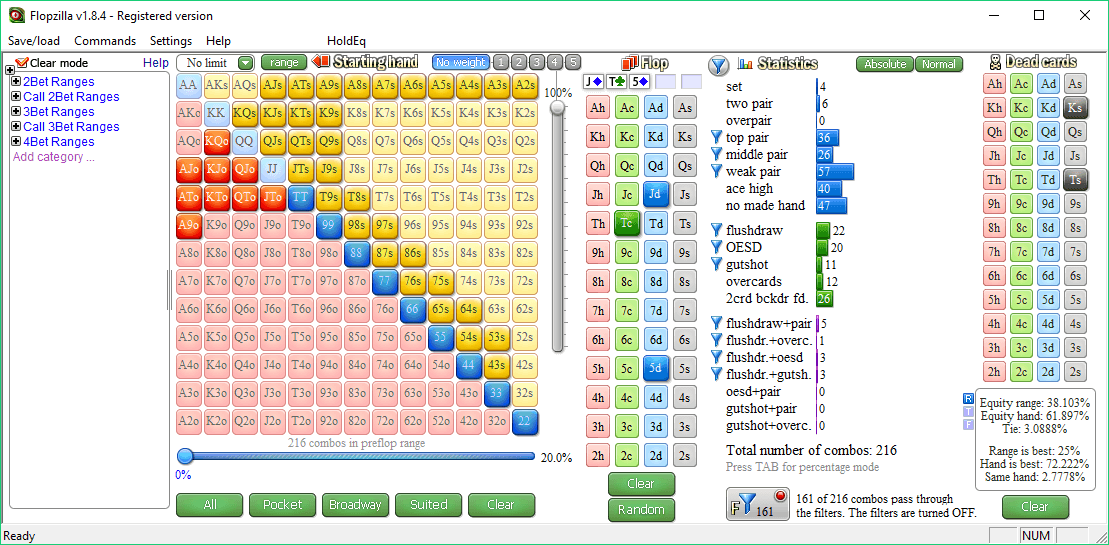
This alone is HUGE information that most people would overlook. This means if you were to CB with total air that you could only expect around 20% of folds and thus any bluff flop CB would not be outright profitable. This means that you don’t need to fear being raised often, and even if you get raised it’s easy to determine the best line. This means that if villain calls you know you don’t need to worry about sets…
See how I’ve already begun taking those frequencies and started to build ideas on my own CB frequency and continue-vs-flop-raise frequency?
But this goes further…
Say you analyze an entire exercise and notice this:
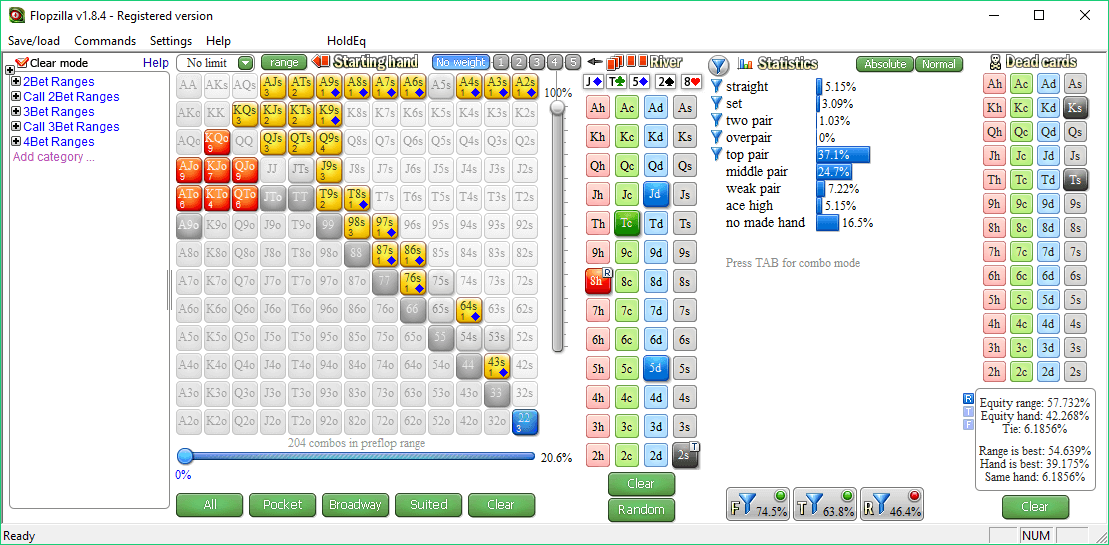

You now see that they can handle a river barrel less than half the time. And if they would ever let go of top pair on the river (say getting rid of the weaker ones like QJ and J9), they would then be folding about 72% of the time on the river – allowing you to barrel bluffs with impunity.
When exploring “% of previous range” you should be looking for the low hanging fruit at first glance. Is someone folding too often? Is someone folding too rarely? Essentially, if someone is folding more than 60% of the time, you should take a note and look to bluff that person as often as possible. Understand which spots/cards influence a person to fold too often, and use those situations against them. Understand which spots create a large continuance from your opponent, and either tone down your immediate bluffing OR looking for multi-street bluffs assuming they continue often now and fold often later.

Want to go a step further? What would betting 1.5x pot do to their river “% of previous range”?
INTERNALIZED CHECK-LIST
Just about every exercise in the workbooks has guiding questions to help with the hand reading process. These are the same questions I would ask myself in these spots and they typically revolve around understand where the cusps of a range are.
For instance, if you open-raise and I’m thinking about 3betting you, I normally ask myself:
♣ Would you fold or flat my 3bet with 99?
♣ Would you fold or flat my 3bet with AJo?
♣ Would you flat or 4bet me with JJ?
I could spend the mental energy to ask myself those same questions for every hand in your open-raising range (and I will sometimes in off-table study analysis), but I largely focus my time on the cusp hands that define a range. If I assume you would always fold 88 to my 3bet and would always continue with TT, then 99 is the cusp. Cusps are unique to different situations and players, but when you can identify a cusp it really helps you narrow-in on the totality of a range.
For postflop exercises, the workbook will ask you questions that get you thinking about hand strengths and how they would continue. Do you think villain would raise or call with top pair/medium kicker? Do you think villain would fold this draw but not that draw? Do you think villain would fast or slow play a set?
These kinds of questions can help you estimate the “% of previous range” and easily identify bluffing opportunities. For instance, if you think villain would fold everything but top pair+ on the flop, it’s almost always outright profitable to bluff in that spot. And I wouldn’t know that unless I’ve explored enough of these situations.
Many of these guiding questions are the same ones I would ask you during a poker coaching session. They are the same questions I ask myself both in real-time and when studying hands away from the table. And you will begin to ask yourself the same questions as well. This ensures you are always focused on the right things and not wasting mental resources on hand types/categories that don’t move the needle.
EXPLORATION OF THE INVERSE LINE
Each exercise guides you through one hand from start to completion. This only looks at one line – the one actually taken in the hand. But there is a lot of value in exploring the inverse line after each exercise.
The inverse line is the one not taken. For instance, say this hand explores facing a double barrel from your opponent. You have QT on Q93 and the turn is a King and you face a second shell. It’s also powerful to ask yourself what if villain had checked the turn instead.
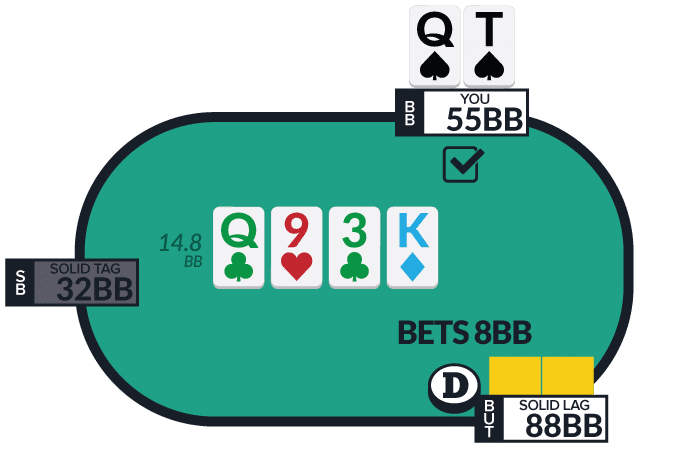
If you assumed villain would bet the turn 60% of the time, which means they would actually check the turn 40% of the time, take a moment to explore a turn check. Ask yourself questions like:
♣ If they would bet the turn would top pair, do they ever check some combos of it and strengthen their checking range?
♣ Would they check the turn with Qx or bet it?
♣ If they check the turn behind with 44, would they stab or check behind on rivers?
♣ Based upon their turn checking range, should I fear the river card being an Ace?
By exploring both lines, their check and their bet, you can start to develop a complete poker strategy. By doing this often enough you will have an inherent idea of which line to take depending on villain’s play. This may seem complex at first, but with hard work, you will see a strategy take shape and you will be prepared to handle a wider variety of situations both immediately and in the future.
COMPARE TO DIFFERENT MODELS (ADVANCED)
There are lots of different models when it comes to building and shaping your own ranges. For instance, if you are building your preflop range in a tournament you might use HRC and take that model directly. If you are building a turn range in a cash game you might use a GTO solver like GTO Range Builder. Or you might use Miller’s 70% model (proposed in Poker’s 1%) as your model of choice.

You may end up using a totally different model. Or you may use a modification of one of the previous range models.
I personally think models are just that – a model. They are not the end all be all, and in many situations, they are a great starting point but not the optimal end-point. What that means is that HRC might suggest a great range for calling a preflop raise in a tournament – but given your edge against this player and the implied odds possible, a slightly wider calling range is actually better.
Or the 70% model might not be ideal when your opponent has zero bluff combos and you can actually exploit them (taking a more optimal line) by folding far more often.
Models are great because they give us a clear starting point. Models are great because they keep us from over-folding (a mistake that many players make is simply folding far too much). But the optimal answer is usually between the model and experience to derive the best range and line in a given situation.
Completing the original exercise is just the beginning. Each exercise lays the groundwork for further exploration and a deeper understanding of the technical elements of the game. Getting an innate feel for combos, frequencies, and inverse ranges will help you craft entire lines and develop a holistic strategy. This kind of work is complex and time-consuming – but the output has insane ROI value.
Remember, you don’t become an excellent hand reader overnight. You don’t develop a complete strategy in a week. But by completing these exercises and going the next-step every time you will begin to see this game in a new light. Finding bluffing opportunities will be more obvious. Finding thinner value bets will be easier. And finding spots to fight where you would have otherwise folded in the past will be a default thought process.
If you haven’t already picked up your workbook, now is the time to do so. Jump in, start working, and see how much your game can improve in the next two months. Seriously, just do one exercise per day for the next two months and see how much clearer your real-time decisions become.
